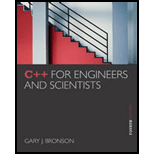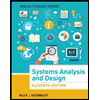
(Practice) Although the total number of bytes varies from computer to computer, memory sizes of millions and billions of bytes are common. In computer language, the letter M representsthe number 1,048,576, which is 2 raised to the 20th power, and G represents 1,073,741,824, which is 2 raised to the 30th power. Therefore, a memory size of 4 MB is really 4 times 1,048,576 (4,194,304 bytes), and a memory size of 2 GB is really 2 times 1,073,741,824 (2,147,483,648 bytes). Using this information, calculate the actual number of bytes in the following:
a. A memory containing 512 MB
b. A memory consisting of 512 MB words, where each word consists of 2 bytes
c. A memory consisting of 512 MB words, where each word consists of 4 bytes
d. A thumb drive that specifies 2 GB
e. A disk that specifies 4 GB
f. A disk that specifies 8 GB
Want to see the full answer?
Check out a sample textbook solution
Chapter 2 Solutions
C++ for Engineers and Scientists
 C++ for Engineers and ScientistsComputer ScienceISBN:9781133187844Author:Bronson, Gary J.Publisher:Course Technology Ptr
C++ for Engineers and ScientistsComputer ScienceISBN:9781133187844Author:Bronson, Gary J.Publisher:Course Technology Ptr Fundamentals of Information SystemsComputer ScienceISBN:9781305082168Author:Ralph Stair, George ReynoldsPublisher:Cengage Learning
Fundamentals of Information SystemsComputer ScienceISBN:9781305082168Author:Ralph Stair, George ReynoldsPublisher:Cengage Learning Systems ArchitectureComputer ScienceISBN:9781305080195Author:Stephen D. BurdPublisher:Cengage Learning
Systems ArchitectureComputer ScienceISBN:9781305080195Author:Stephen D. BurdPublisher:Cengage Learning C++ Programming: From Problem Analysis to Program...Computer ScienceISBN:9781337102087Author:D. S. MalikPublisher:Cengage Learning
C++ Programming: From Problem Analysis to Program...Computer ScienceISBN:9781337102087Author:D. S. MalikPublisher:Cengage Learning Systems Analysis and Design (Shelly Cashman Serie...Computer ScienceISBN:9781305494602Author:Scott Tilley, Harry J. RosenblattPublisher:Cengage Learning
Systems Analysis and Design (Shelly Cashman Serie...Computer ScienceISBN:9781305494602Author:Scott Tilley, Harry J. RosenblattPublisher:Cengage Learning





